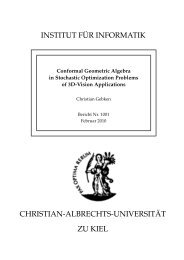Curry: An Integrated Functional Logic Language
Curry: An Integrated Functional Logic Language
Curry: An Integrated Functional Logic Language
Create successful ePaper yourself
Turn your PDF publications into a flip-book with our unique Google optimized e-Paper software.
to the suspension of e1 is instantiated, the left expression e1 will be evaluated in the subsequent<br />
step. Thus, we obtain a concurrent behavior with an interleaving semantics. However, a sophisticated<br />
implementation should provide a fair selection of threads, e.g., as done in a Java-based<br />
implementation of <strong>Curry</strong> [25].<br />
A computation step for an expression e attempts to apply a reduction step to an outermost<br />
operation-rooted subterm in e by evaluating this subterm with the definitional tree for the function<br />
symbol at the root of this subterm. Although it is unspecified which outermost subterm is evaluated<br />
(compare second inference rule in Figure 2 for constructor-rooted expressions), we assume that a<br />
single (e.g., leftmost) outermost subterm is always selected. The evaluation of an operation-rooted<br />
term is defined by a case distinction on the definitional tree. If it is a rule node, this rule is applied.<br />
<strong>An</strong> or node produces a disjunction where the different alternatives are combined. Note that this<br />
definition requires that the entire disjunction suspends if one disjunct suspends. This can be relaxed<br />
in concrete implementations by continuing the evaluation in one or branch even if the other branch<br />
is suspended. However, to ensure completeness, it is not allowed to omit a suspended or branch<br />
and continue with the other non-suspended or branch [23]. For a similar reason, we cannot commit<br />
to a disjunct which does not bind variables but we have to consider both alternatives (see [5] for a<br />
counter-example).<br />
The most interesting case is a branch node. Here we have to branch on the value of the<br />
top-level symbol at the selected position. If the symbol is a constructor, we proceed with the<br />
appropriate definitional subtree, if possible. If it is a function symbol, we proceed by evaluating<br />
this subexpression. If it is a variable and the branch is flexible, we instantiate the variable to<br />
the different constructors, otherwise (if the branch is rigid) we cannot proceed and suspend. The<br />
auxiliary function replace puts a possibly disjunctive expression into a subterm:<br />
replace(e, p, {σ1 e1, . . . , σn en}) = {σ1 σ1(e)[e1]p, . . . , σn σn(e)[en]p} (n ≥ 0)<br />
The overall computation strategy on disjunctive expressions takes a disjunct σ e not in solved<br />
form and evaluates e. If the evaluation does not suspend and yields a disjunctive expression, we<br />
substitute it for σ e composed with the old answer substitution.<br />
Soundness and completeness results for the operational semantics can be found in [23]. Note<br />
that the evaluation of expressions is completely deterministic if the concurrent conjunction of<br />
constraints does not occur.<br />
Conditional rules. Note that the operational semantics specified in Figure 2 handles only unconditional<br />
rules. Conditional rules are treated by the rules in Figure 3. If a conditional rules<br />
is applied, the condition and the right-hand side are joined into a guarded expression, i.e., a pair<br />
of the form c|r. Due to the additional evaluation rules, a guarded expression is evaluated by an<br />
attempt to solve its condition. If the condition is solvable (i.e., reducible to success), the guarded<br />
expression is replaced by its right-hand side. If the condition is not solvable and does not suspend,<br />
the disjunct containing this guarded expression will be deleted by the definition of computation<br />
steps, i.e., the application of the conditional rule fails and does not contribute to the final result.<br />
Sharing and graph rewriting. For the sake of simplicity, this description of the operational<br />
semantics is based on term rewriting and does not take into account that common subterms are<br />
shared (see Section 2.3.1). We only note here that several occurrences of the same variable are<br />
67
















